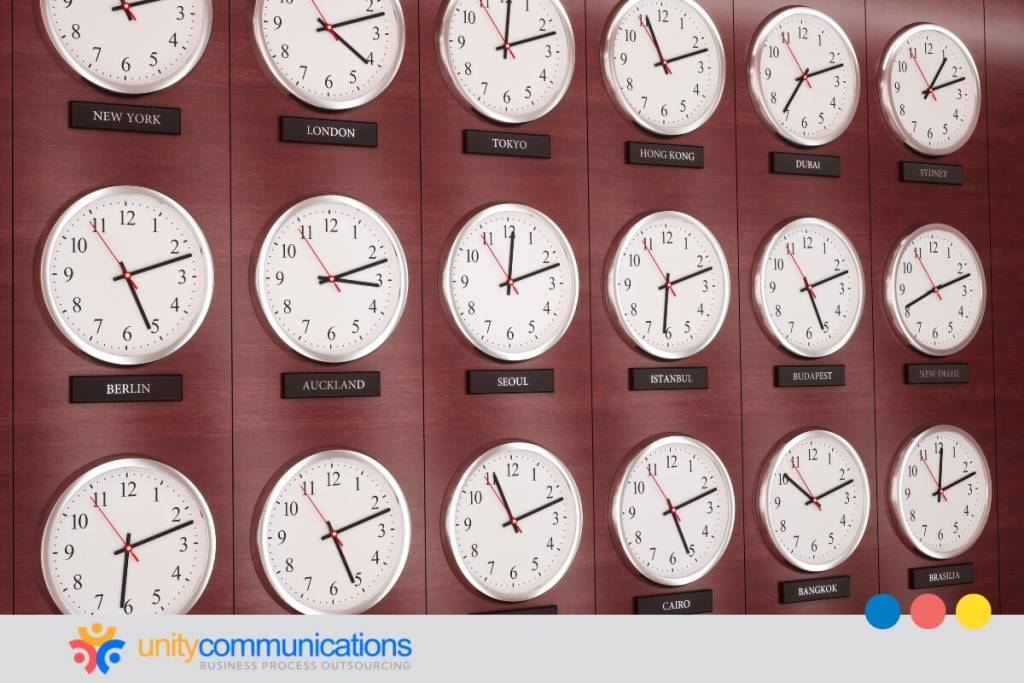Table of Contents
Knowledge process outsourcing (KPO) offers expert skills and cost savings that many in-house teams lack. However, time zone differences can quickly diminish these benefits.
They slow down decisions, delay deliverables, and create operational blind spots. Simple approvals or feedback loops can stretch for days without proper coordination, risking productivity and client trust.
This article explores strategies to manage time zone challenges in KPO to enhance collaboration and maintain project continuity. Read on to learn how to maximize the advantages of this business process outsourcing model.
6 tips to overcome time zone challenges in KPO

Smart time management keeps KPO projects running smoothly. These six tips help improve scheduling, communication, and cross-region workflows.
1. Maximize overlapping business hours
To address time zone problems in KPO, look for overlapping business hours. Even a narrow window of two to three shared hours can be valuable for clarifying daily tasks or getting timely approvals.
Leverage the overlap by coordinating meetings using shared calendars with time-zone indicators. If the window is short, consider rotating shifts or adjusting schedules for more real-time collaboration on complex or urgent tasks.
Other tips include:
- Prioritize high-value interactions. Use shared hours for discussions on strategic decisions.
- Prepare ahead of meetings. Share agendas, documents, and questions before meetings to keep conversations focused and productive. Schedule 15-minute syncs to align priorities and flag blockers early.
- Assign clear roles during live check-ins. Designate a facilitator, note-taker, and decision-maker to keep overlapping meetings efficient and outcomes action-oriented.
Maximizing overlapping hours improves communication, accelerates decision-making, and strengthens connections among global teams.
2. Structure tasks for asynchronous productivity
With 52% of remote workers favoring async-first policies, more prefer flexible communication. To overcome time zone challenges in KPO, let teams work independently during offline hours.
Break projects into smaller, clearly defined tasks. Include clear instructions, deliverables, and deadlines. Then, document everything using shared tools such as Notion or Google Workspace.
Assign decision-making authority locally. Regional teams can resolve issues and prioritize tasks instead of waiting for approval from headquarters or cross-regional managers. They can also adapt to changes in real time.
For example, a KPO team in the Philippines handling financial reporting spots a data discrepancy. The lead can immediately escalate to the client or request corrections from the source. This process reduces bottlenecks and improves response times. It promotes ownership and agility in your KPO setup.
3. Implement “follow the sun” operations
A popular KPO strategy for distributed teams is the “follow the sun” model, where you hand off work to a cross-border unit at the end of the shift. For example, a U.S.-based firm might pass a task to a Philippine-based KPO team at the end of their day and receive updates when they return the next morning.
This approach:
- Enhances productivity by enabling continuous progress across time zones
- Improves customer satisfaction through faster response and resolution times
- Increases innovation by involving diverse perspectives from global teams
- Optimizes costs by minimizing project downtime
- Reduces turnaround times by keeping work moving while others are offline
- Balances workloads by distributing tasks evenly and preventing team burnout
- Supports global service coverage by ensuring 24/7 availability for international clients
Building a strong system of trust, version control, and communication is essential to making this model effective. Set clear rules for handoffs, including what constitutes a “complete” task. Use project management tools to track revisions and progress. With the correct setup, your KPO engagement can operate while you sleep.
4. Leverage time-sensitive tools and platforms
The right tools can also help manage time zone challenges in KPO by strengthening collaboration and alignment.
- Project management platforms such as Asana, Trello, Jira, and ClickUp display tasks and deadlines in each user’s local time. This helps prevent confusion and ensures teams can track progress without misaligned expectations. Real-time updates also reduce the risk of delays or missed steps.
- Communication tools such as Slack and Microsoft Teams support timely conversations. When paired with time-zone indicators or scheduling bots, they help teams coordinate without the friction of mismatched schedules.
- Loom and recorded walkthroughs are great alternatives to live meetings. They allow teams to share updates and explain processes on their own time.
- Tools such as Clockwise or World Time Buddy help teammates plan workdays around global schedules. These apps send reminders adjusted to each person’s local time, minimizing late responses and missed deadlines.
- Otter.ai and Fireflies transcribe meetings automatically. They highlight action items and share notes with those who cannot attend.
The right platforms allow teams to communicate seamlessly and stay aligned regardless of time zone differences.
5. Establish flexible communication protocols
Rigid meeting schedules are impractical when your teams span multiple time zones. Instead, implement flexible communication that respects work hours and keeps everyone informed.
Define when and how to use synchronous (such as video calls) and asynchronous (e.g., email or task comments) communication methods. For instance, schedule virtual meetings for brainstorming or decision-making. Then, use emails and instant messaging for status updates, documentation, or routine check-ins.
Build a culture that doesn’t expect instant replies. However, set “core response hours” to foster accountability.
Flexible, accountable communication fosters a productive, supportive environment for KPO teams, wherever they are.
6. Align expectations through clear service agreements
Time zone challenges in KPO make it essential for clients and providers to agree on service-level agreements (SLAs) that outline expectations upfront. These include turnaround times, working hours, escalation paths, and reporting standards.
Knowing what to deliver, when to be available, and how to respond to issues minimizes confusion and ensures smooth collaboration.
However, you must review SLAs regularly to reflect shifts in workload, staffing, or strategic priorities. For example, teams can shift from setting overly cautious deadlines to faster, more realistic timelines as collaboration improves.
Ultimately, strong SLAs maintain accountability and performance regardless of the clock.
Why is time zone alignment critical in KPO workflows?

Unlike BPO, KPO involves comprehensive research, deep analytics, and critical insights. Delays due to time zone differences can severely affect project timelines, delivery quality, and decision-making in the following ways:
- Real-time collaboration becomes harder. Scheduling live brainstorming sessions or troubleshooting calls becomes stressful. Employees might attend meetings at odd hours, rush through essential conversations, or struggle with fatigue and burnout.
- Delays in responses can slow down operations. Without a plan, even small questions can trigger 24-hour delays, stalling progress and frustrating the team.
- Waiting on decisions causes bottlenecks. When key decision-makers are in different time zones, getting quick approvals or making fast pivots takes time. It can push you to make risky, unsupported decisions.
- Information gets lost during handoffs. Without live check-ins, crucial context and details can be lost. Relying solely on written updates risks confusion and duplicate work.
- Team energy and connection can diminish. When collaboration feels disconnected and fragmented, team morale can decline. Employees might feel isolated or out of sync. This leads to disengagement, loss of creativity, and poor task ownership.
A study found 14% of remote workers struggle with time zone differences, showing how varied hours can still disrupt team dynamics.
Managing time zone challenges in KPO is essential to unlocking the full value of the partnership. For example, giving internal and external teams two to four hours of daily overlap boosts coordination, speeds decisions, and reduces async risks.
It helps you catch issues early, such as delays, confusion, or tasks going off track. You can fix problems before they grow and keep everyone working toward the same goals. Regular check-ins also help you spot gaps in resources or misaligned priorities. This keeps the project running smoothly and gives you better control without slowing down the team.
The bottom line
When unmanaged, time zone differences can be a logistical nightmare, diminishing the effectiveness of KPO. The right approaches, however, can turn problems into opportunities for 24/7 productivity and stronger collaboration. These include intelligent scheduling, asynchronous workflows, and strategic communication.
When you overcome time zone challenges in KPO, you can build trust, maintain momentum, and remain competitive. Let’s connect if you need help managing a productive and collaborative distributed team.




